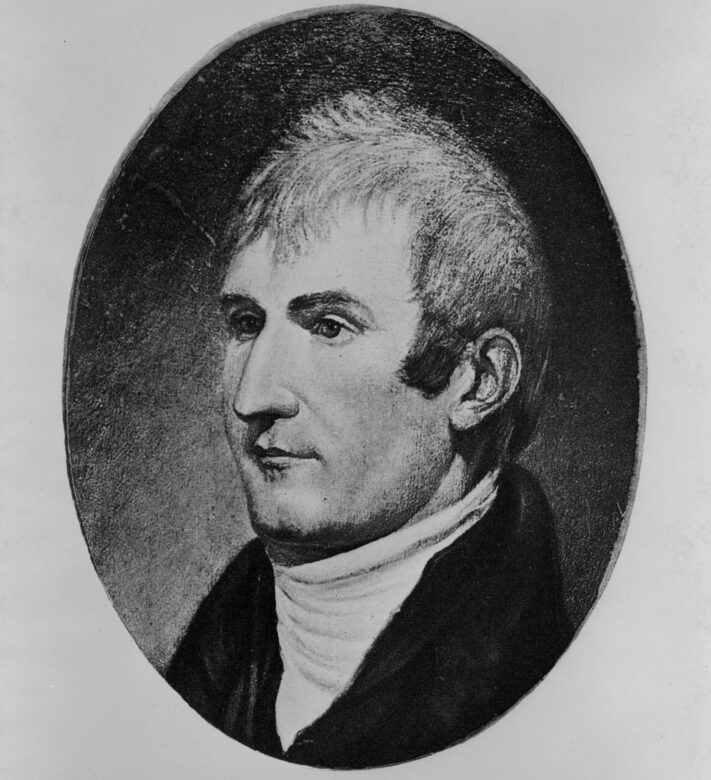Sharing White House History about Thomas Jefferson
The White House Historical Association and presidential libraries, historic homes, and museums have a shared goal of providing access to...

Main Content
How Long? 3 minutes

Meriwether Lewis
Library of CongressFrom 1804 to 1806, Meriwether Lewis and William Clark led the Corps of Discovery, an expedition created by President Thomas Jefferson for the purpose of charting and exploring land acquired from the Louisiana Purchase. Along the way, the expedition was to make natural observations, establish relationships with Native American tribes, and establish routes of travel for future settlement.
Before leading the expedition that embarked from near St. Louis on May 14, 1804, Meriwether Lewis served as private secretary to President Thomas Jefferson. In his letter offering Lewis the position, the president noted his particular “knowledge of the Western country, of the army and all of its interests and relations has rendered it desirable . . . that you should be engaged in that office [as private secretary].”1 Much of the planning for the expedition thus occurred at the White House while Lewis was employed as private secretary while working with Jefferson on the upcoming monumental voyage across the west. Jefferson and Lewis discussed logistics and expectations of the journey. Lewis made trips to Harpers Ferry, Virginia, and Philadelphia acquiring the necessary vessels for dangerous waterway navigation, and rifles, tomahawks and knives, to serve as means of protection, purchasing food, and as presents to native tribal leaders.2 Lewis undertook what today would be called a “crash course” in the study of cartography and the natural sciences, traveling to meet with the scientific luminaries of the time.3 In Lancaster, Pennsylvania, he met with the well-known surveyor Andrew Ellicott and in Philadelphia he met with such personages as Dr. Benjamin Rush, Dr. Benjamin Smith, Dr. Caspar Wistar, and Robert Patterson.4

President Thomas Jefferson used as his office, the room that would later become the State Dining Room. In this painting by Peter Waddell, A Bird that Whistles (In Jefferson's Cabinet, 1803), President Jefferson meets with Meriwether Lewis.
The White House Historical AssociationOn July 4, 1803, President Jefferson wrote Lewis’s official orders to head west, eventually meeting the expedition at St. Louis in May of 1804 to begin the arduous journey. In his letter, the president told Clark, “In the journey which you are about to undertake for the discovery of the course and source of the Mississippi and of the most convenient water communication from thence to the Pacific Ocean, your party being small, it is to be expected that you will encounter considerable dangers...” 5
President Jefferson used the Entrance Hall of the White House to showcase objects brought back east from the expedition, and from another western expedition conducted by Zebulon Pike from 1806 to 1807. 6 The journals from the Lewis and Clark expedition describe packing objects for shipment back to Washington. On April 4, 1805 for example, the expedition packed into boxes examples of mountain ram and elk horns in addition to various Native American objects to be sent back east including a buffalo robe, depicting a battle between several Native American tribes. 7 In September of 1806, Lewis and Clark returned to Camp Dubois near St. Louis. Shortly after his arrival, he wrote to President Jefferson in Washington, “It is with pleasure that I announce to you the safe arrival of myself and party. . . In obedience to your orders we have penetrated the Continent of North America to the Pacific Ocean, and sufficiently explored the interior of the country.” 8
These initial journeys westward represented the desire to move American settlements and communities well beyond the Mississippi River. The centrality of the White House in both planning and in the later display of artifacts sent from these expeditions highlights the national character of the early stages of American westward expansion.
The White House Historical Association and presidential libraries, historic homes, and museums have a shared goal of providing access to...
Read Digital EditionForeword, William Seale"A Well-Ordered Household": Domestic Servants in Jefferson's White House, Lucia StantonJefferson's White House Dinner Guests,...
Thomas Jefferson was born on April 13, 1743 in Albemarle County, Virginia to Jane and Peter Jefferson. His father was a Virginia...
In April 1789, George Washington took the oath of office in New York City. Constitutional guidelines for inaugurations are sparse, offering...
It was President Thomas Jefferson who first established the traditions of a Fourth of July celebration at the White House....
On July 11, 1798, Congress passed legislation that created the United States Marine Corps and the Marine Band, America's oldest professional musical...
Biographies & Portraits
The White House Grounds began as approximately 85 acres of land chosen by George Washington and was refined and cultivated by...
NUMBERS 1 THROUGH 6 (COLLECTION I) WHITE HOUSE HISTORY • NUMBER 1 1 — Foreword by Melvin M. Payne 5 — President Kennedy’s Rose Garden by Rachel Lambert...
JAMES ARCHER ABBOTT is the Executive Director of the Lewes Historical Society in Lewes, Delaware. His publications include JANSEN, JANSEN...
The origin of the "American Presidents" by Genevieve Ryan Bellaire is somewhat unique. One year, Genevieve's father asked her to...
Elaine Rice Bachmann